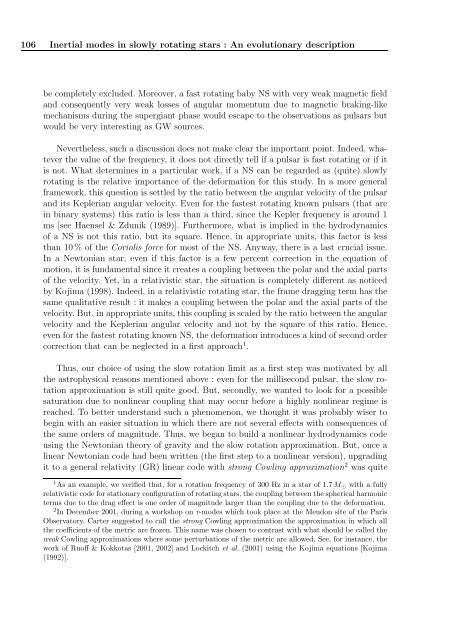Ecole doctorale de Physique de la région Parisienne (ED107)
Ecole doctorale de Physique de la région Parisienne (ED107)
Ecole doctorale de Physique de la région Parisienne (ED107)
You also want an ePaper? Increase the reach of your titles
YUMPU automatically turns print PDFs into web optimized ePapers that Google loves.
106 Inertial mo<strong>de</strong>s in slowly rotating stars : An evolutionary <strong>de</strong>scription<br />
be completely exclu<strong>de</strong>d. Moreover, a fast rotating baby NS with very weak magnetic field<br />
and consequently very weak losses of angu<strong>la</strong>r momentum due to magnetic braking-like<br />
mechanisms during the supergiant phase would escape to the observations as pulsars but<br />
would be very interesting as GW sources.<br />
Nevertheless, such a discussion does not make clear the important point. In<strong>de</strong>ed, whatever<br />
the value of the frequency, it does not directly tell if a pulsar is fast rotating or if it<br />
is not. What <strong>de</strong>termines in a particu<strong>la</strong>r work, if a NS can be regar<strong>de</strong>d as (quite) slowly<br />
rotating is the re<strong>la</strong>tive importance of the <strong>de</strong>formation for this study. In a more general<br />
framework, this question is settled by the ratio between the angu<strong>la</strong>r velocity of the pulsar<br />
and its Keplerian angu<strong>la</strong>r velocity. Even for the fastest rotating known pulsars (that are<br />
in binary systems) this ratio is less than a third, since the Kepler frequency is around 1<br />
ms [see Haensel & Zdunik (1989)]. Furthermore, what is implied in the hydrodynamics<br />
of a NS is not this ratio, but its square. Hence, in appropriate units, this factor is less<br />
than 10 % of the Coriolis force for most of the NS. Anyway, there is a <strong>la</strong>st crucial issue.<br />
In a Newtonian star, even if this factor is a few percent correction in the equation of<br />
motion, it is fundamental since it creates a coupling between the po<strong>la</strong>r and the axial parts<br />
of the velocity. Yet, in a re<strong>la</strong>tivistic star, the situation is completely different as noticed<br />
by Kojima (1998). In<strong>de</strong>ed, in a re<strong>la</strong>tivistic rotating star, the frame dragging term has the<br />
same qualitative result : it makes a coupling between the po<strong>la</strong>r and the axial parts of the<br />
velocity. But, in appropriate units, this coupling is scaled by the ratio between the angu<strong>la</strong>r<br />
velocity and the Keplerian angu<strong>la</strong>r velocity and not by the square of this ratio. Hence,<br />
even for the fastest rotating known NS, the <strong>de</strong>formation introduces a kind of second or<strong>de</strong>r<br />
correction that can be neglected in a first approach 1 .<br />
Thus, our choice of using the slow rotation limit as a first step was motivated by all<br />
the astrophysical reasons mentioned above : even for the millisecond pulsar, the slow rotation<br />
approximation is still quite good. But, secondly, we wanted to look for a possible<br />
saturation due to nonlinear coupling that may occur before a highly nonlinear regime is<br />
reached. To better un<strong>de</strong>rstand such a phenomenon, we thought it was probably wiser to<br />
begin with an easier situation in which there are not several effects with consequences of<br />
the same or<strong>de</strong>rs of magnitu<strong>de</strong>. Thus, we began to build a nonlinear hydrodynamics co<strong>de</strong><br />
using the Newtonian theory of gravity and the slow rotation approximation. But, once a<br />
linear Newtonian co<strong>de</strong> had been written (the first step to a nonlinear version), upgrading<br />
it to a general re<strong>la</strong>tivity (GR) linear co<strong>de</strong> with strong Cowling approximation 2 was quite<br />
1 As an example, we verified that, for a rotation frequency of 300 Hz in a star of 1.7 M⊙ with a fully<br />
re<strong>la</strong>tivistic co<strong>de</strong> for stationary configuration of rotating stars, the coupling between the spherical harmonic<br />
terms due to the drag effect is one or<strong>de</strong>r of magnitu<strong>de</strong> <strong>la</strong>rger than the coupling due to the <strong>de</strong>formation.<br />
2 In December 2001, during a workshop on r-mo<strong>de</strong>s which took p<strong>la</strong>ce at the Meudon site of the Paris<br />
Observatory, Carter suggested to call the strong Cowling approximation the approximation in which all<br />
the coefficients of the metric are frozen. This name was chosen to contrast with what should be called the<br />
weak Cowling approximations where some perturbations of the metric are allowed. See, for instance, the<br />
work of Ruoff & Kokkotas [2001, 2002] and Lockitch et al. (2001) using the Kojima equations [Kojima<br />
(1992)].
















